After a lot of hard work and a lot of editing, I finally finished making my TED-Talk presentation and memorized my script.
After I answered my sub questions and main inquiry question, I started working on my script. The first script that I made was way to long, so I kept having to shorten it until it was perfect. I also re-read it a lot to make sure everything made sense. Once I thought my script was good, I exchanged scripts with a partner and we read each others to make sure there were no mistakes. After that I met with Ms. Robert to make the final edits.
Making my presentation was really fun! Every slide has images that relates to the topic I’m talking about at that point. While I was making it, I kept editing to where things were placed because I knew that a lot of people were going to see it, so I wanted to make it as good as possible.
Memorizing my script wasn’t that hard. It took a couple of days, but it wasn’t really challenging. After a lot of practice reading my script over and over again, I knew it like the back of my hand.
I really hope that people will like my presentation. Can’t wait for CapCon!

Recent Comments